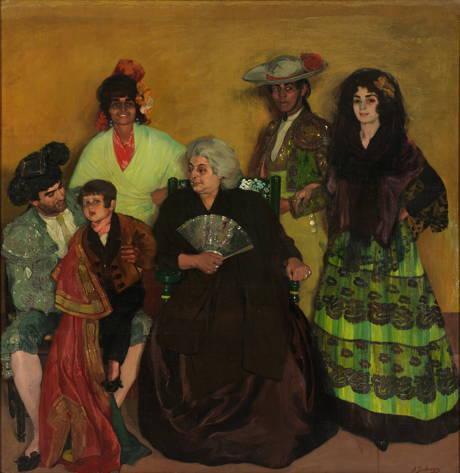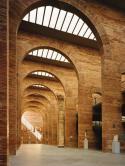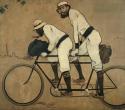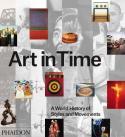Art Of The Day Weekly
#467 - from 6 April 2017 to 12 April 2017

Ignacio Zuloaga, The Family of the Gypsy Bullfighter. Oil on canvas, 1903. New York, The Hispanic Society of America
IN THE AIR
Letter from Madrid: the Hispanic Society and its hidden treasures
MADRID - The Hispanic Society of America, based in New York, is a unique institution although the public does not know it well – if at all. The fact that it is closed until 2019 for renovations will probably help to give it the international aura it deserves, especially after the exhibition the Prado museum dedicates to it. It was created at the beginning of the 20th century by one of the wealthiest heirs in the U.S.A., Archer Milton Huntington, who had such a passion for Spain that he wrote poems in Spanish and decided to study the language and the culture relentlessly for ten years before visiting the country for the first time. The HSA has accumulated a colossal wealth in Spanish as well as in Latin American art. The collections include 18,000 pieces and a library with 250,000 volumes (among them 250 incunabulum) and span 4,000 years, with bell-shaped ceramics and Celtiberian jewellery, “casta paintings” from 19th-century Mexico and paintings by Zuloaga. The selection sent to Madrid includes masterpieces from Islamic Cordoba, three paintings by Velázquez (more than at the Louvre), a rare black book of hours, maps by the Vespucci, a sublime female saint by Zurbarán, polychrome sculptures of saints and one of the richest selections of portraits by Sorolla. This very diverse group is brilliantly set up in a quasi night atmosphere in real glass show windows, very rare in our days.
• Tesoros de la Hispanic Society of America at the Prado Museum, from 4 April to 10 September 2017. Catalogue: 448 p., €37.
EXHIBITIONS
Rafael Moneo, an assessment
MADRID – Rafael Moneo (born in 1937), together with Calatrava and Bofill is among the Spanish architects with an international renown. He designed a few museums, like most architects who want to be famous in the 20th century, and was awarded the Pritzker prize in 1996. There is the Thyssen-Bornemisza, which hosts this retrospective highlighting his work as a theorist with drawings and models, as well as the renovation of the Prado (with the Jerónimos building) and his masterpiece, the national museum of antique art in Mérida, which he finished in 1986, and which looks like a giant brick basilica. Moneo is at the crossroads of functionalism of the school of Madrid and his thoughts on the evolution of the contemporary city. He also designed the cathedral of Los Angeles and had a “gesture” that was more of Brutalist architecture in regard to its environment (like the Guggenheimright nearby), the Kursaal of San Sebastián. The architect does not look down upon more modest projects, such as the wine cellar he is currently working on, the Bodega Palacios, in the grandiose landscape of the Bierzo region.
• Rafael Moneo at the Museo Thyssen-Bornemisza, from 4 April to 11 June 2017. Catalogue: 316 p., €38.
Casas, the man from the Four Cats
MADRID - Ramon Casas (1866-1932) went to study in Paris as of the age of 15. During the decade of the 1880, he soaked up all the influence of the avant-gardes of that time, represented in particular by Toulouse-Lautrec. Once back home in Barcelona, he was one of the engines of Catalan modernism, with his daring nudes, his independent women and his advertising images. He played an important role in developing the talent of Picasso since, together with Romeu and Rusiñol Casas was one of the hosts of the famous cabaret of the Quatre Gats from 1897 to 1903 where Picasso had his very first exhibition in 1900. This exhibition, with over 100 paintings, launched for the Casas year that began in 2016 in Sitges for the 150th anniversary of his birth, shows all the aspects of a painter with a humanistic nature and a great colourist.
• Ramón Casas at the CaixaForum, from 8 March to 11 June 2017. Catalogue: 272 p., €25.
ARTIST OF THE WEEK
Leandro Erlich in the kingdom of illusion
Born in 1973, he is one of the most cosmopolitan Argentine artists. He was the son of architects from Buenos Aires and studied and lived in the USA and in France. He exhibited in all the major Biennales (Venice, São Paulo, Istanbul, Whitney in New York) where his installations have met a constant public success. He inverts the perspective on common places such as a changing room, a pool or an elevator, often through the bias of mirrors, glasses or textiles, and invites the public to see in daily life the source of possible situations that can be absurd, poetic or absurd. The inspiration is not to be found only in the remarkable works of artists such as Escher or Magritte but also in the writings supplied by Borges or Pérec.
• Two installations by Leandro Erlich (Changing Rooms and Cloud) are presented at the Fondation Teléfónica in Madrid until 23 April 2017.
• Changing Rooms is also exhibited at the Galleria Continua in Boissy-le-Châtel.
OPENINGS OF THE WEEK

MINIMALISM, NEW YORK, 1960-1980
7 April 2017 - NÎMES - Carré d'art
For the 40th birthday of Centre Pompidou, an overview of a major movement in contemporary art (Huddle by Peter Moore, photo Simone Forti)
BOOKS
Rereading art history
Among our choices of leisure we now easily go see an exhibition. Consequently permanent collections in museums - synonyms of a more systematic or “boring” study of the history of art – suffer from an absence of attendance. It is true that the history of chronological events is no longer popular. Yet there are original ways of putting eras into order. It is the case of this big, well-illustrated book that chose to invert perspective. Rather than starting far away in the past, with the Egyptians or the Sumerians for example, the authors start with the most recent movements, such as Relational Art or Abject Art. From there they look back at the various influences. This goes to show that what we sometimes consider new, not always is. Sceptics will say that contemporary art often repeats itself. Others, like Lavoisier, will say that everything can be transformed and nothing is lost. In any case it is good to catch, like in a family tree that branches out, what we owe to ancestors such as Precisionism, Orphism or Picturalism. The rewinding stops with the art of the steppes, the one of the nomadic and freedom-loving Scythes of the first millennium.
• Air in Time, Phaidon, 2016, 368 p., €59.95
IN BRIEF
ATHENS - Documenta 14 opens its Greek exhibition on 8 April 2017 (until 16 July).
PARIS - The Salon international du livre d'art is being held from 7 to 9 April 2017 at the Grand Palais.
SÃO PAULO - The modern and contemporary art fair La foire d'art moderne SP-ARTE ais being held from 6 to 9 April 2017.




